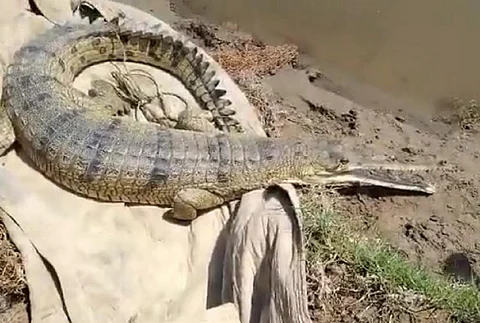

A screengrab from the video shared by Bilal Mustafa on Twitter.
This story has been updated
A gharial (Gavialis gangeticus) has been seen in Pakistan’s Punjab province for the first time after three decades and could have been from a population reintroduced on this side of the Radcliffe Line in 2017, an expert has told Down To Earth.
On May 14, 2023, Bilal Mustafa, a postgraduate researcher currently based at the Wildlife Conservation and Research Unit (WildCRU) in the University of Oxford, tweeted a video on microblogging site Twitter which he said had gone viral.
The video showed a couple of men, likely fishers, trying to free a thrashing gharial, a crocodilian unique to the Indian subcontinent.
“A gharial is seen (for the) first time in Pakistan after three decades. It was thought to be extinct. A video is viral about fishermen getting it rid from a net. It’s critically endangered according to the IUCN-SSC Red List,” Mustafa wrote.
“A possibility is it has come from India during floods last year according to locals and stayed there in the Satluj river. They said there are almost 10 individuals but the location has not still (been) confirmed. India has reintroduced the gharial in the Harike wetland which is 50 km from the border,” Mustafa added.
The Harike wetland is where the Beas and the Satluj, two of the three eastern rivers of the Indus river system and whose waters are allotted to India according to the 1960 Indus Waters Treaty, meet.
Between 2017 and 2021, some 94 gharials were released into the Beas river in the Amritsar, Tarn Taran and Hoshiarpur districts under three phases of the Punjab (India) government’s programme to bring back the species to its rivers.
The animals were brought mostly from the Chambal basin in Madhya Pradesh.
Gitanjali Kanwar, senior coordinator of World Wildlife Fund for Nature-India, who has been part of the project along with officials of the Punjab forest and wildlife department, said Mustafa’s claim appeared highly plausible, yet acquiring further on-the-ground information is imperative to ascertain its veracity.
Kanwar explained that we are aware of individuals utilising unmanned sections of the Satluj at the international border, which increases the likelihood of gharials crossing into Pakistan.
“We know that gharials have made their way from Harike into the main channel of the Satluj, which crosses the international border and flows into Pakistan. However, further information is necessary to determine the exact distance at which the animal has been observed from the international border,” Kanwar added.
Hussainiwala, the last town on the Indian side in Ferozepur district, faces Ganda Singh Wala on the Pakistan side, just across the Satluj.
Kanwar added that the river becomes highly braided after a few kilometres upon leaving Harike. “It looks to me the animal has not gone into Pakistan through the main channel that passes through Hussainiwala but one of the minor ones,” Kanwar added.
Kanwar said gharials have a tendency to migrate downstream, particularly during their juvenile and sub-adult stages. While the Punjab Forest Department and her team were successful in rescuing and recovering individuals that had ventured into canals originating from Harike, those that had entered the main channel of the Satluj did not need to be rescued as they were in their natural habitat.
In his tweet thread, Mustafa noted that gharials were mentioned to be extinct in most of Pakistan’s rivers in 1978 according to the Pakistan Wildlife Conservation Strategy Report.
“The reason being the construction of barrages, illegal killing for skin trade and the use of gill net for their capture,” he added.
Mustafa pointed out that the earliest mention of the gharial in the area that is now Pakistan was a depiction by Emperor Babur in the 14th century, which is currently in the possession of the British Library.
“…(In the depiction), he mentioned about a beast as green as a parrot with a large ghara on its snout who came up on the river bank in straight lines to bask. (It hunted) fish,” Mustafa noted.
“The earliest depiction of gharial in the world is from the seals of the Indus Valley Civilisation which is present in the Ashmolean Museum in Oxford. In the year 1913, they could be found as far north as Peshawar. One female which was shot at Ferozepur is still stuffed in our museum and there are many other specimens from the Beas, Ravi and Satluj rivers,” Mustafa told Down To Earth (DTE) over email.
He also tweeted: “I hope that this will transform into a cross-country collaboration between Pakistan and India just like the one with Nepal. I wish that the Satluj became a Schengen area for the gharials as they don’t recognise any borders.”
“I very much hope that the governments of both countries will take this matter seriously and instead of playing politics, will act for their successful cross-border conservation. Hopefully, this initiative will be a precursor to opening borders between the people of both countries and the gharial will act as an ambassador of friendship and brotherhood between these two countries,” Mustafa told DTE.